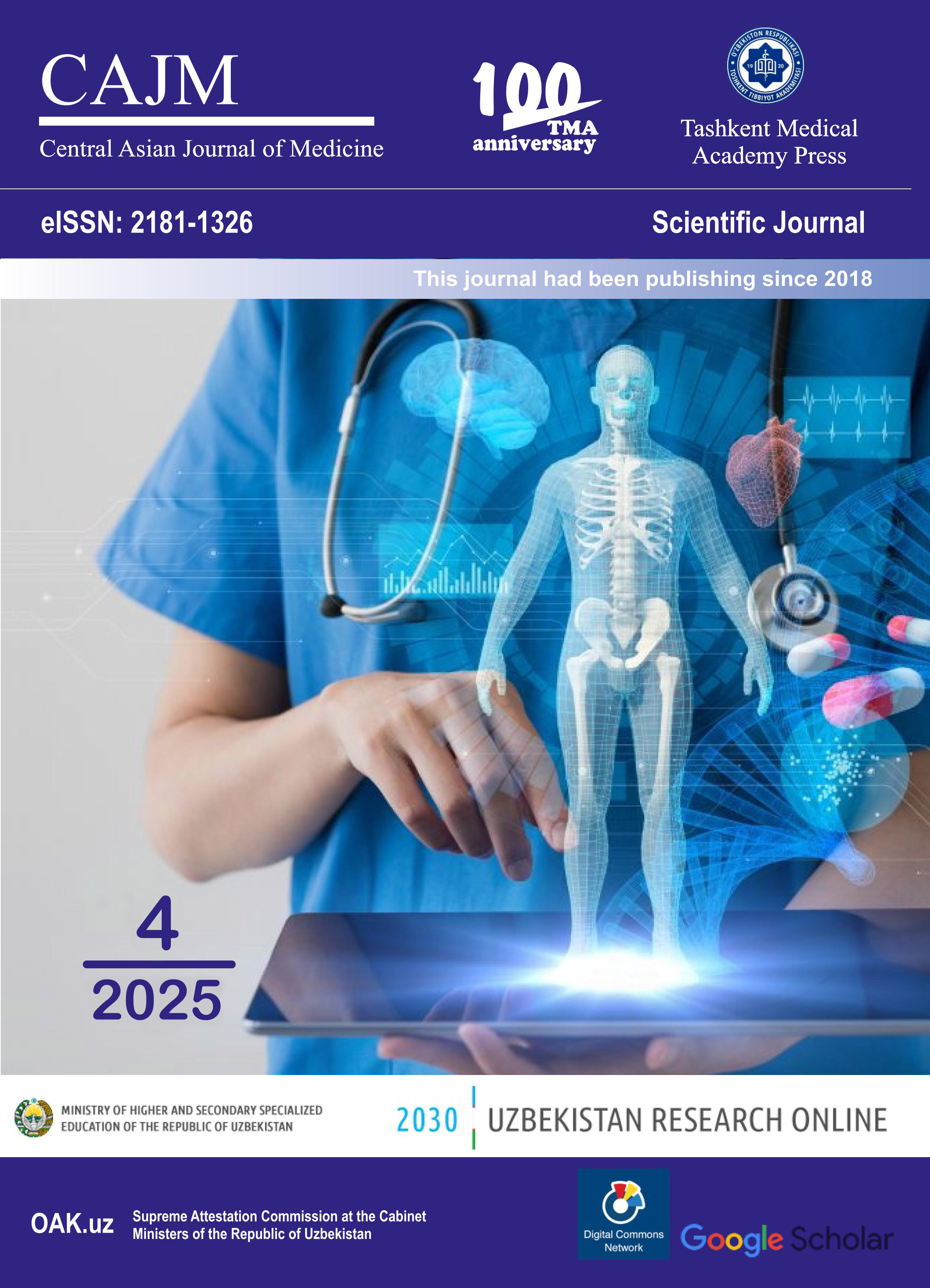BALANCED AMINO ACID NUTRITION IN SEPSIS WITH ORGAN FAILURE
Keywords:
sepsis, multiple organ failure, balanced amino acids, parenteral nutrition, intensive care, inflammatory markers, metabolic support.Abstract
Background: Sepsis complicated by multiple organ failure (MOF) remains a critical challenge in intensive care. Adequate nutritional support plays a key role in modulating the metabolic response and improving clinical outcomes.Objective: To evaluate the clinical efficacy of parenteral nutrition enriched with balanced amino acid solutions in patients with sepsis and MOF compared to standard formulations.Methods: A total of 80 postoperative patients with sepsis and MOF were enrolled. The intervention group (n=43) received parenteral nutrition with balanced amino acids (Gepa, Nefro), while the control group (n=37) received standard amino acid solutions. Biochemical, hemodynamic, and clinical parameters were assessed over 14 days.Results: Patients receiving balanced amino acids showed earlier reductions in catabolism, improved protein metabolism (albumin, transferrin levels), lower inflammatory markers (CRP, fibrinogen), and better SOFA/APACHE II scores by day 14. Duration of mechanical ventilation and time to gastrointestinal recovery were shorter.Conclusion: The inclusion of balanced amino acids in parenteral nutrition significantly improved clinical outcomes in septic patients with MOF, emphasizing the value of personalized metabolic support in critical care.
References
Berger MM, et al. A pilot study of nutritional support enriched with glutamine, arginine, and omega-3 fatty acids in ICU patients. Clin Nutr. 2006; 25(4):6 04–612. https://doi.org/ 10.1016/j.clnu.2006.02.001
Bistrian BR. Parenteral nutrition in sepsis. JPEN. 2009;33(5):496–503. https://doi.org/ 10.1177/0148607109335323
Braunschweig CL, et al. Enteral versus parenteral nutrition: a meta-analysis of clinical out¬comes. JPEN. 2001;25(5):282–288. https://doi.org/10.1177/0148607101025005282
Calder PC. Functional roles of amino acids in the immune system. Proc Nutr Soc. 2013;72(1):69–77. https://doi.org/10.1017/S0029665112002947
Casaer MP, Van den Berghe G. Nutrition in the acute phase of critical illness. N Engl J Med. 2014;370(25):2450–2451. https://doi.org/10.1056/NEJMc1401893
De Bandt JP, Cynober L. Therapeutic use of branched-chain amino acids in burn, trauma, and sepsis. J Nutr. 2006;136(1 Suppl):308S–313S. https://doi.org/10.1093/jn/136.1.308S
Dickerson RN. Optimal nutrition support for the trauma patient. Nutr Clin Pract. 2004;19(5):421–428. https://doi.org/10.1177/0115426504019005421
Djamshir K. Uzakov, Nodir SH. Mirubaydov, and Nematdjon K. Ibragimov. ALGO-RITHM FOR THE MANAGEMENT OF ENDOTOXIN-INDUCED HEMODYNAMIC DISOR-DERS. CAJM, no. 2, pp. 111–121, Mar. 2025.
Heyland DK, et al. Randomized trial of glutamine and antioxidants in critically ill patients. N Engl J Med. 2013;368(16):1489–1497. https://doi.org/10.1056/NEJMoa1212722
Ichai C, et al. Metabolic support in sepsis and multiple organ failure. Ann Intensive Care. 2021;11:89. https://doi.org/10.1186/s13613-021-00878-0
Jones NE, et al. The effect of parenteral glutamine supplementation on outcomes in criti¬cally ill patients. Crit Care Med. 2016; 44(3):468–474. https://doi.org/10.1097/CCM.000000000 0001429
Koekkoek WAC, et al. Personalized nutrition in critical care: a position paper. Clin Nutr. 2021;40(12):6355–6364. https://doi.org/10.1016/j.clnu.2021.08.002
Luiking YC, et al. Arginine in critical illness. J Nutr. 2005;135(6 Suppl):1682S–1690S. https://doi.org/10.1093/jn/135.6.1682S
Manzanares W, Hardy G. Nutrition therapy in critically ill patients: a personalized ap-proach. Curr Opin Clin Nutr Metab Care. 2016; 19(4):279–283. https://doi.org/10.1097/MCO.0000 000000000300
McClave SA, et al. Guidelines for the provision and assessment of nutrition support therapy in the adult critically ill patient. JPEN J Parenter Enteral Nutr. 2016;40(2):159–211. https://doi.org/ 10.1177/0148607115621863
Preiser JC, et al. Amino acid supplementation in critically ill patients: a systematic review. Clin Nutr. 2015;34(5):705–712. https://doi.org/10.1016/j.clnu.2015.01.011
Reintam Blaser A, et al. Gastrointestinal function in intensive care patients: terminology, definitions and management. Intensive Care Med. 2012; 38(3):384–394. https://doi.org/10.1007/ s00134-011-2459-y
Singer M, et al. The Third International Consensus Definitions for Sepsis and Septic Shock (Sepsis-3). JAMA. 2016;315(8):801–810. https://doi.org/10.1001/jama.2016.0287
Vincent JL, et al. Epidemiology of sepsis and multiple organ dysfunction syndrome in crit¬ical care. Lancet Respir Med. 2020;8(9):880–890. https://doi.org/10.1016/S2213-2600(20)30222-X
Wernerman J. Clinical use of glutamine supplementation. J Nutr. 2008;138(10):2040S–2044S. https://doi.org/10.1093/jn/138.10.2040S
Wischmeyer PE. Tailoring nutrition therapy to illness and recovery. Crit Care. 2017;21(Suppl 3):316. https://doi.org/10.1186/s13054-017-1906-8.

